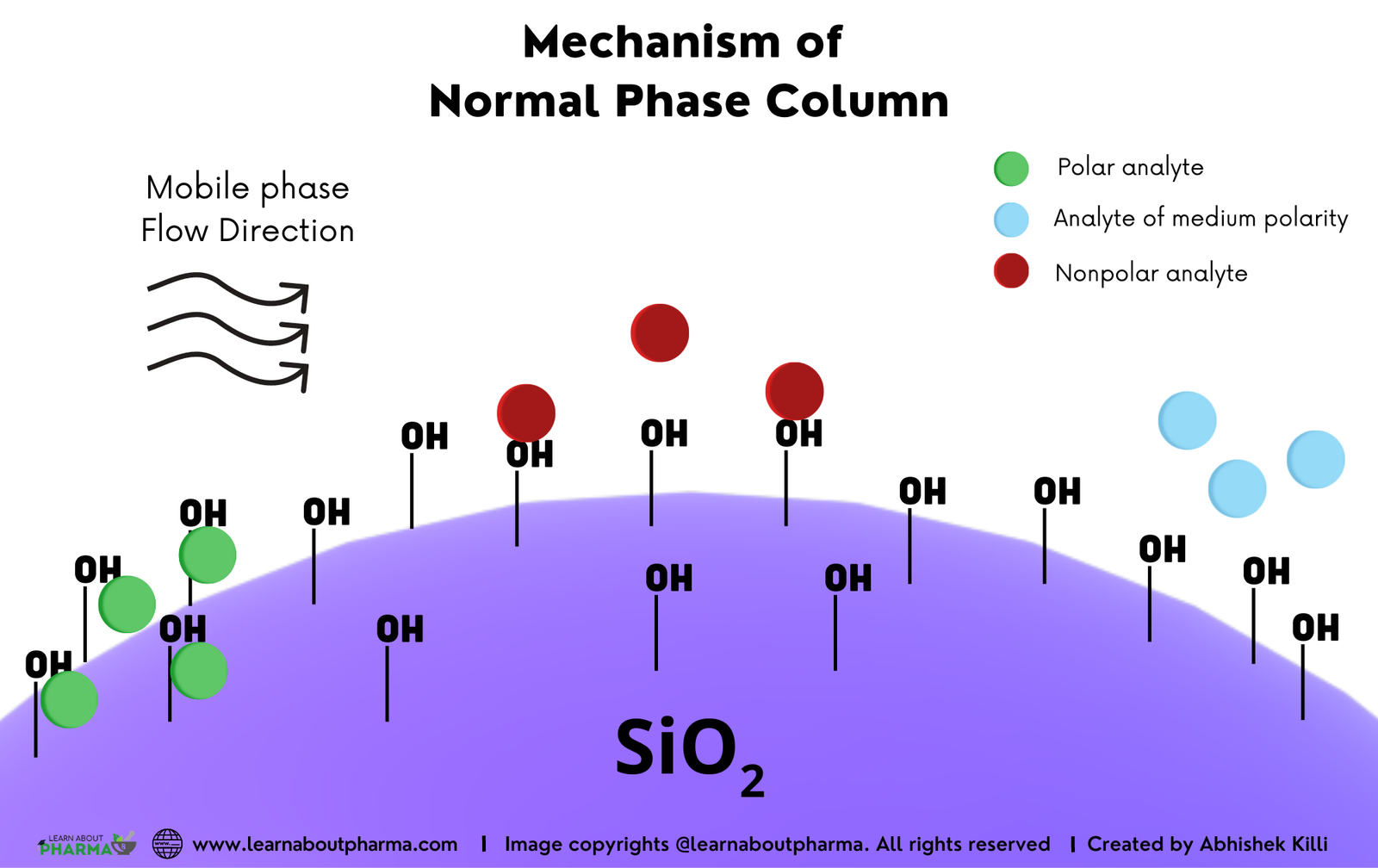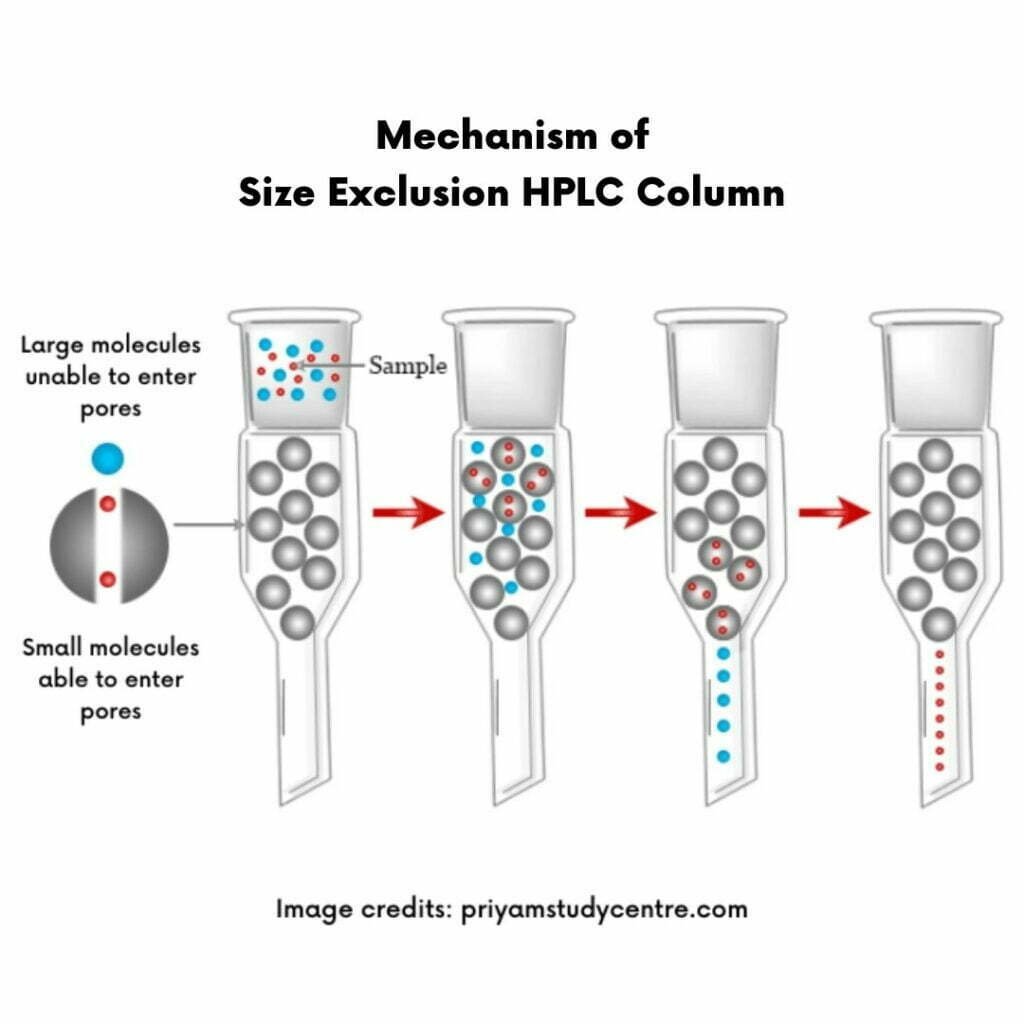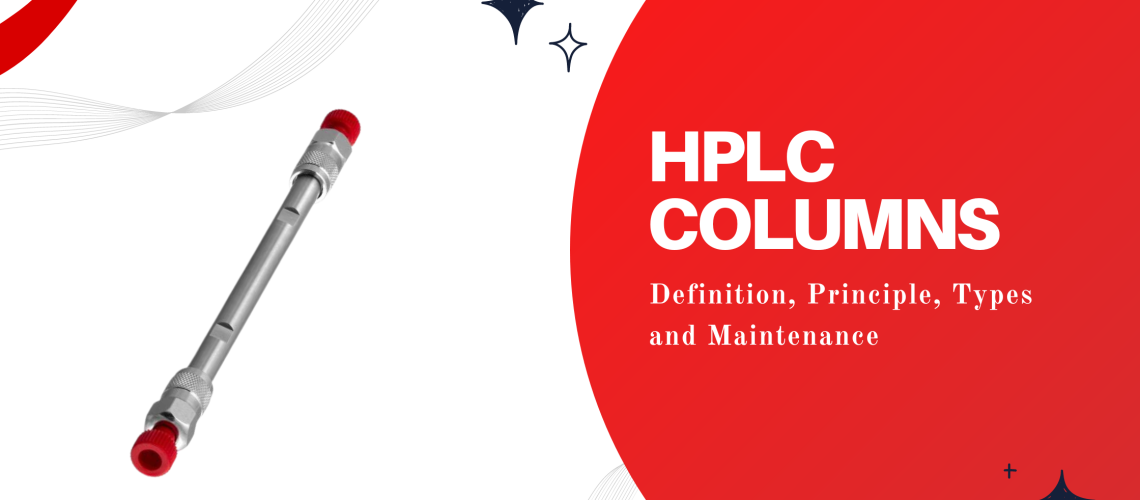Definition:
HPLC columns are specialized devises used in modern HPLC to separate complex to simple analyte mixtures. This is a place where the sample is passed through the stationary phase with the mobile phase to achieve separation of molecular components. A column is the place where the mobile phase is in contact with the stationary phase, forming an interface with enormous surface.
Principle of HPLC Columns:
HPLC column is considered to be the heart of HPLC system. A column work on the separation principle where the analyte (sample) is distributed between the stationary (packing material of the column) and mobile phase (Eluent). Depending on the nature and composition of the analyte, the molecules are retarded while passing through the stationary phase. This is because of the intermolecular interactions between the analyte molecules and the porous stationary phase in the column, which finally results in different migration times for an analyte mixture thereby separation of analyte ingredients is achieved.
Types of HPLC columns:
We knew that HPLC columns are most important for the chromatographic process; therefore, its important to use right type of column for correct use, else it would lead to inaccurate results or failed separation of analyte. A wide variety of columns are available in the market for various analytical applications. Classified based on the separation mechanism and composition, here are the most commonly used HPLC columns discussed below:
- Normal Phase HPLC Columns:
These HPLC columns uses stationary phase that are either inorganic adsorbents such as silica or alumina or moderately polar chemically bonded phases having functional groups such as aminopropyl, nitrophenyl, and diol that are chemically bonded on the silica gel support. Normal phase HPLC columns are more polar than the mobile phase, therefore, analyte retention is enhanced as the relative polarity of the stationary phase increases and the polarity of the mobile phase decreases. Retention also increases with increasing polarity and number of adsorption sites in the column. This means that retention is stronger on adsorbents with larger specific surface areas.
This class of HPLC column is used for analytes with small molecules such as organic acids, some drugs, and a range of biomolecules including glycosylated proteins. Compounds soluble only in organic solvents should be run on Normal Phase (polar) HPLC columns. Compounds with structural or stereo isomeric differences should also be separated on normal-phase columns. These days, bonded stationary phases for normal phase columns are becoming increasingly popular, owing to their virtues of faster column equilibration and being less prone to contamination by water.

- Reverse Phase HPLC Columns:
These HPLC columns have stationary phases with chemically modified hydrophobic surfaces where porous silica stationary phases have been modified with ligands of various chemistry and sizes. These columns have a non-polar or less polar stationary phase than the more polar mobile phase. In other words, it is the reverse of normal phase chromatography. Reverse phase HPLC columns are the most widely used in the labs because of its versatility and are best known for testing purity of substances like proteins and water.
These columns having a silica based hydrophobic packing material are typically made by covalent bonding of organsilanes on the silica surface. Octadecylsilane was the first commercially available silica-based bonded phase and is still the most commonly utilized. Bonded alkyl type ligands with C1, C4, C8 and C12 are often are used as stationary phase in these columns whereas aqueous organic mixtures like water-methanol or water-acetonitrile is used as a mobile phase. These days, polar end capped, polar embedded phases are also being used which provides increases chromatographic sensitivity and also enhanced retention of polar analytes.
- Ion exchange HPLC columns:
Analytes that require ionization are analysed using Ion exchange columns which have charged packing and separates polar molecules based on their charge. Separation of molecules due to attractive ionic forces molecules in the analyte and the charged stationary phase. As the sample passes through the charged column, all sample components separate based on its level of attraction to the stationary phase, causing the sample components to separate at different rates.

Ion exchange columns can be either cationic or anionic in nature. Anion exchange columns retain and separate anions or negatively charged ions. Cation-exchange columns retain and separate positively charged cations. Ion exchange HPLC columns can be used to separate many types of analytes and are commonly used for separations of phenols, thiols, DNA, vitamins, carbohydrates, amino acids, and proteins.
- Size Exclusion HPLC Columns:
These columns are made of combination of polymers like polysaccharides and silica which act as the main type of adsorbent used in size exclusion HPLC. The HPLC columns do not reply on interaction with the analyte components but rather utilize sieving effect based on molecular weight of the analyte components. The packing of these columns have both micropores and mesopores where the size distribution of these pores determines the size of the molecules in the sample that can diffuse into the pores. The extent to which molecules can diffuse into the pores determines the retention time and elution profile. Molecules that are too large to enter the pores pass through the column rapidly, eluting as a single peak after the void volume.

Since the smallest molecules can penetrate all of the pores, they can be distributed in the whole liquid volume of the column and their average migration speed is therefore the slowest. Molecules of intermediate size may penetrate into the pore space but may not come close to the pore walls, so their centre of mass will be allocated closer to the centre of the pores where flow velocity is higher. Their average migration speed is higher. The biggest molecules experience steric hindrance in permeation inside the packing pore space and move through the column primarily around the particles with the fastest possible speed. As a result, the biggest molecules come out of the column first, and the smallest ones come out last. Size exclusion HPLC columns are used primarily for the separation of proteins and carbohydrates.
Maintenance and Storage of HPLC Columns:
HPLC columns act as an accumulation medium such that any compound dissolved in the mobile phase may somehow retain on the column stationary phase. These trapped molecules could significantly alter the surface properties of the packing material and gradually change the retention pattern for analytes analyzed on that column and could eventually lead to gradual elution of ghost peaks in samples that are analyzed in a sequence. Therefore, as a part of its maintenance, it is very important to clean and regenerate columns after use and store appropriately as recommended by the manufacturer. Here are a few recommendations:
- Flush the column in the reverse flow direction with about 5-10 column volumes of a solvent or buffer. Flushing in the reverse flow direction will expel any potential particulate / contaminant matter from the inlet frit or head of the column.
- Flush the column with freshly prepared mobile phase for at least 150 column volumes or until the column is fully equilibrated
- For reverse phase columns, it is recommended to maintain the column at (55°C) in column oven during flushing.
- After successful regeneration of column, conduct the column performance test as required.
- Keep it tightly capped when not in use. Do not allow the column to dry out.
- Prolonged storage of columns for more than a week or longer, use a mobile phase that inhibits bacterial and mold growth.
- For reverse phase and normal phase columns, it is recommended to store in a suitable organic solvent like methanol and Hexane respectively.
- It is recommended to avoid precipitating salts in the column and routinely monitor the column performance



